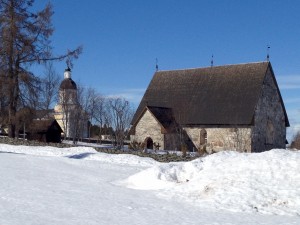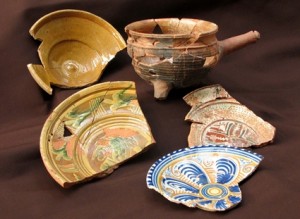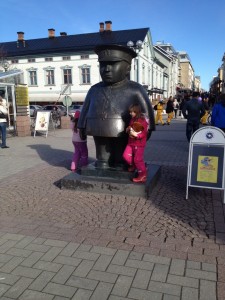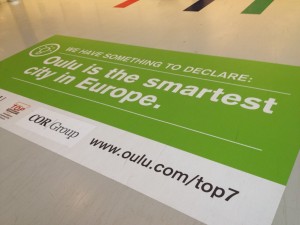Parks Canada Cuts
 Many SHA members realize that Parks Canada has recently been subjected to absolutely draconian cuts that risk crippling one of the world’s most influential stewards for cultural and natural heritage and historical archaeological research. Very few historical archaeology labs are not outfitted with a host of essential Parks Canada publications like Olive Jones and Catherine Sullivan’s Parks Canada Glass Glossary, Lynne Sussman’s The Wheat Pattern, its Archaeological Recording Manual, and many of the technical publications available on the SHA web page. In January, 2014 the SHA will hold its conference in Quebec City, so it is especially demoralizing to know that by the time we arrive most of Parks Canada’s archaeology staff will have been released. At the Quebec center, a team of 12 archaeologists was reduced to one; in Cornwall six of seven staff members were eliminated; and just one archaeologist will be responsible for the whole 120,000 km2 of the Canadian Arctic.
Many SHA members realize that Parks Canada has recently been subjected to absolutely draconian cuts that risk crippling one of the world’s most influential stewards for cultural and natural heritage and historical archaeological research. Very few historical archaeology labs are not outfitted with a host of essential Parks Canada publications like Olive Jones and Catherine Sullivan’s Parks Canada Glass Glossary, Lynne Sussman’s The Wheat Pattern, its Archaeological Recording Manual, and many of the technical publications available on the SHA web page. In January, 2014 the SHA will hold its conference in Quebec City, so it is especially demoralizing to know that by the time we arrive most of Parks Canada’s archaeology staff will have been released. At the Quebec center, a team of 12 archaeologists was reduced to one; in Cornwall six of seven staff members were eliminated; and just one archaeologist will be responsible for the whole 120,000 km2 of the Canadian Arctic.
The SHA has written a letter to the Canadian Prime Minister joining our international colleagues including the Society for American Archaeology who have appealed to the Canadian government to reconsider the scope of these transformations in one of the world’s models for historic preservation, cultural heritage, and historic archaeology. Let’s hope that by the time we meet in Quebec in January, 2014 the Canadian government will reconsider the breadth and sweep of these changes.
School’s Out for Summer: Explore Arcadia Mill
Arcadia Mill Archaeological Site in Milton, Florida provides a multi-disciplinary educational experience for people of all ages. Arcadia Mill represents the first and largest water-powered industrial complex in northwest Florida. Between 1828 and 1855, the industrial complex developed into a multi-faceted operation that included two water-powered sawmills, a railroad, bucket factory, shingle mill, textile mill, and an experimental silk cocoonery. In addition to the industrial facilities, Arcadia had an ethnically diverse community populated by enslaved African American laborers, Anglo American workers, and an elite Anglo American management class. In the late 1980s, local awareness and efforts made by the Santa Rosa Historical Society and the University of West Florida helped to save a portion of the Arcadia Mill site from residential development.
Today, Arcadia Mill functions as an archaeological site that is open to the public. Our facilities include an elevated boardwalk with interpretive signage, a newly renovated visitor’s center and museum, and an outdoor pavilion with working replicas. Arcadia hosts thousands of visitors annually including a large number of students on scheduled field trips. Our educational programming at Arcadia has made great strides over the last few years, but we are always looking for new ways to reach our younger audience.
During the summer months when field trips have tapered off, Arcadia hosts a portion of the University of West Florida archaeological field school. This gives our visitors a chance to see an active archaeological dig; however we are missing part of our audience and the opportunity to use the dig as an educational tool for school children. With a little brainstorming, we came up with the first of several steps to take in order to beat the summer time slump.
A year ago we launched a pilot summer camp, Explore Arcadia Mill, as a new way to provide educational programming when school is out of session. The weeklong camp features a multi-disciplinary approach that is designed for upcoming 4th through 6th graders. Campers learn about geography, history, archaeology, and historic preservation through lessons that feature hands-on educational crafts, group projects, and outdoor activities. Arcadia Mill is a case study for many of the lessons such as understanding the landscape, how to use historical documents, and how historic preservation has helped to save the site.
The archaeology portion of the camp involves lessons and activities focused on principles and ethics. The campers learn about fundamental concepts such as the Law of Superposition and then test their knowledge on our stratigraphy canvas. We also teach them about the different tools that archaeologists use followed by a seek-and-find exercise using real photographs from our field school. Once we have completed the introduction to archaeology, the campers are taken to the field school excavations where they can visualize everything they’ve learned. The campers do not participate in the actual field work, but they observe and document the visit in their field books.

Campers visit the field school site to learn more about archaeological excavations (Courtesy of Arcadia Mill Archaeological Site)
The campers really enjoy the archaeology lessons and activities in the classroom, but the crowning achievement is the ability to incorporate an active archaeological dig. Aside from being an excellent visual aid, the ability to visit the field school helps us to educate the campers on ethics, stewardship, and professionalism. At the end of the week the campers combine everything they’ve learned and create a primary document, but for fun sake it is really a scrapbook! The parents or guardians of each camper are invited to come view the scrapbooks and learn about what went on throughout the week. Therefore, the campers become the teachers and the camp directors stand by with pride.
With one successful camp season behind us and another just around the corner, the possibilities for activities and lessons have become endless. The camp was giant lesson for us as professionals since we quickly learned what worked and what didn’t work. It will get much easier with time, but now we are ready to implement additional programming. Where do we go from here? The camp was such a great experience that we are now looking at large scale or year round programming. The idea of an after school program came into question, but is that too much? There’s a fine line between educational programming and babysitting. It would be a large undertaking, but it could be very rewarding and worthwhile. Have you tried an after school program or a similar concept?
Boom, Baby!
 Boom baby! Though many archaeologists cringe at its origins, how many times will we hear that catch phrase on our digs this summer? It’s catchy and the show that spawned it, American Diggers, is a hit for SpikeTV. Everything about the show is anathema to professional archaeologists: the destructive excavation methods, lack of concern for context and, especially, the sale of artifacts. But what can you expect from the network that brought you 1000 Ways to Die? So how do we explain National Geographic’s very similar show, Diggers?
Boom baby! Though many archaeologists cringe at its origins, how many times will we hear that catch phrase on our digs this summer? It’s catchy and the show that spawned it, American Diggers, is a hit for SpikeTV. Everything about the show is anathema to professional archaeologists: the destructive excavation methods, lack of concern for context and, especially, the sale of artifacts. But what can you expect from the network that brought you 1000 Ways to Die? So how do we explain National Geographic’s very similar show, Diggers?
National Geographic!?! Aren’t they on our side? They are an organization that has published the most recognizable popular scientific magazine in the world. They have covered and supported thousands of archaeological digs and have several archaeologists on their staff. What happened?
The response from the archaeological community has been immediate and passionate. People Against National Geographic Channel’s Diggers and Spike’s American Diggers Facebook pages have surfaced with thousands “liking” the message to Stop the Looting. Professional archaeologists have taken to the media as well with the SAA speaking against the shows to NPR and other professionals speaking out in the St. Augustine Record. Have they listened? Maybe.
I recently attended a workshop convened by the National Geographic Society to discuss their new show. It seems they were genuinely surprised at the professional outcry over its airing. And, unlike SpikeTV, they were embarrassed and wanted to discuss what might be done. In attendance were professional archaeologists, avocational metal detectorists (AMD), and network and program executives. The discussion that followed was lively, though civil, and is summarized here.
The producers led off the meeting by declaring that the traditional documentary was dead. Only PBS could afford to broadcast an hour-long archaeology program. Commercial television requires more popular subject matter. So, how do you make a show that is both popular AND ethical? There were many suggestions made to make the show more palatable to the archaeologists. The main points were that a concern be shown for location and context, and that the artifacts not be monetarily valued or sold. It was suggested that the show’s AMDs work with real archaeologists, helping them out while abiding by their rules. It has worked elsewhere. We’ll see what happens.
I think the biggest takeaway that I had from the meeting was how badly we as archaeologists have failed in getting our message out to the general public. Or at least in persuading them as to what our discipline is really all about. It’s more than just finding stuff. It’s the story the stuff has to tell. Our underwater colleagues have seen the public sympathies go out to the treasure salvors. Now it’s the terrestrial archaeologist’s turn to watch the viewing public tune-in to shows that portray archaeology as a lucrative scavenger hunt.
So, what do we do? Write off a large chunk of the population as beyond our reach? Buy an artifact price catalog and sell out to the next network that calls? Surely there is some middle ground that gets our point across without boring the public to tears? It’s become apparent that these shows are not going away. Paul Mullins and I have both been contacted by producers pitching ideas similar to American Diggers. The calls are worrisome, but I worry more that they will quit calling and produce their shows with no input from us.
Read theTranscript from the meeting with the National Geographic Society.
SHA 2013: More Calls for Papers
Globalization, immigration, transformation:
The Society for Historical Archaeology’s 46th Annual Conference on Historical and Underwater Archaeology
January 9-12, 2013 Leicester, Great Britain
If you would like to attract speakers to your proposed symposium by advertising on this blog, please get in touch. We highlighted three sessions last month, and four more can be found below. If you’re interested in participating in a session, please contact the individual session organisers.
Gendering Consumer Choices
Suzanne Spencer-Wood (Oakland University, Michigan; spencerw@oakland.edu)
Chapters in the 1987 edited volume Consumer Choice in Historical Archaeology related consumption to households, family size, composition, life cycle, and occupations and probate inventories of women as well as men. However, the consumer choice framework was not explicitly gendered. Consumer choice is gendered in many ways, such as who selects consumer goods for a household and who consumes goods. Many consumer goods were often manufactured specifically for one gender or another, such as clothing, cosmetics, perfume, jewelry, hats, shoes, watches, scissors, chairs, machines, etc. Papers in this symposium explicitly theorize and analyze a variety of relationships between gender and consumer choice.
Traveling
Julie King (St Mary’s College of Maryland; jking@smcm.edu) and Philip Levy (University of South Florida; plevy@usf.edu)
Phil Levy & I are organizing a session for SHA Leicester focused on traveling; it’s open-ended at this time because the topic is so broad. If you are interested, let us know. Everyday travel, tourism past and present, migration, archaeologist as traveler, travel writing and the experience of place, war as travel… theorizing travel, case studies… any topic focused on the study of travel in some context that takes a material perspective is welcome. So far there are three or four of us. Send us an email if this is of interest and you will be at SHA.
Tearing Down Walls: The Architecture of Household Archaeology
James Nyman (University of North Carolina, Chapel Hill; Jamesnyman16@hotmail.com) and Kevin Fogle (University of South Carolina)
We are organizing an household archaeology session entitled “Tearing Down Walls: The Architecture of Household Archaeology” for the 2013 Society for Historical Archaeology meeting in Leicester. The session seeks presenters who are using innovative household theory or methods. The following is a working abstract for the session:
Household archeology is a methodological and theoretical approach to domestic sites that can address various research interests from demography and socioeconomic relationships to the use of space and the landscape approach. The goal of this session will be to bring together multiple viewpoints regarding the household as a unit of archaeological analysis. We hope to highlight recent developments with household archaeology that improve upon the ways that we traditionally conceptualize how households are made meaningful through activity and as centers for social relationships in the past. We seek a diversity of examples that span temporal and geographic space, and seek to highlight how households are connected to, and influence, multiple processes at the global and local levels.
If this proposed session interests you, please send us an abstract by June 22 2012, or email prior to that date with ideas or questions.
Modern Technology, Past Culture: Emerging Effects of Information Technologies on Archaeological Practice
Edward Gonzalez-Tennant (Monmouth University, Edward.Gonzalez-Tennant@monmouth.edu) and Quentin Lewis (UMass Amherst, quentin@anthro.umass.edu)
Recent advances within information technologies present Historical Archaeologists with an array of novel and unique practices to add to our toolkit. Geographic Information Systems, archaeological visualization, and various web technologies offer the possibility of far-reaching, or even radical changes to the discipline. Rather than accept the inevitability of such practices and techniques as progress, we want to explore the possibilities and pitfalls of the applications of these technologies to historical archaeology. This session’s primary goal is to bring together a group of researchers examining the acquisition, processing, storage, and dissemination of digital archaeological information from a theoretically-focused standpoint. We are less concerned with specific technical procedures and more interested in papers addressing the material, historical, political, and cultural implications such technologies hold for the practice of historical archaeology. As such, we will consider papers for inclusion in our session from any region or time frame, but we ask that they address the following themes:
- — The role of information technologies in transforming the ways archaeologists think about and visualize places, regions, and past cultural processes
- — The ethical and political implications of incorporating information technologies into archaeological practice, both positive and negative.
- — Issues of essentialism and representation which arise at the confluence of archaeology and emerging/emergent technologies.
- — The possibilities or limits of using new information technologies to realize new public archaeologies.
- — The potential of information technologies to construct “new” archaeological data.
Along with exploring new research that connects historical archaeology and information technologies, we hope to engender conversation(s) around the social implications of incorporating these technologies within the archaeological toolkit, as conceived both theoretically and methodologically. Please send your abstract to session organizers by June 15th. We will make our final selections no later than June 20th.
Image: “Muro Occidentale o del Pianto” (Western Wall or Wailing Wall) by Fabio Mauri (1993) CC BY-NC-SA 2.0 via Flickr
Ed and Judy Jelks Student Travel Award
All students who are presenting a paper at the 2013 SHA conference in Leicester should consider applying for the Ed and Judy Jelks Student Travel Award. Two $500 awards will be presented to students who are presenting a paper or poster or participating in a symposium at the 2012 conference in Baltimore. Applicants must be currently enrolled in a graduate degree program, be a member of SHA, and be presenting a paper at the 2013 conference. To apply, please send a brief email to me, Charlies Ewen, the Jelks Award committee chair (ewenc@ecu.edu), outlining how participation in the SHA Conference will advance your career and research, and indicate how presentation of your research will benefit other SHA members. Along with this please send your abstract submission and a copy of your curriculum vitae. Reference letters from advisors are not required, but please identify your major advisor(s) in your letter or CV. Award checks will be sent to you after the conference.
The deadline for submissions is November 15th, so please consider applying now if you are a student who is presenting, and please encourage any student advisees or colleagues whose costs would be defrayed by this award. Do email me directly if you have any questions.
To read more about the history of this award, which recognizes the contribution and dedication of Ed and Judy Jelks to the professional development of archaeology students, please visit this recent post by Paul Mullins.
The SHA Guide to Higher Education
 Are you an undergraduate interested in historical archaeology and mulling the possibility of going to graduate school? Do you need some guidance on what options are out there for you? Do you have a specific thematic (forensic, African Diaspora, Atlantic World, etc.) or temporal focus that you would like to learn more about? Do you find it difficult to navigate the archipelago of departments and individual faculty that a simple web search inevitably yields? Well, the SHA is here to help, with our Guide to Higher Education!
Are you an undergraduate interested in historical archaeology and mulling the possibility of going to graduate school? Do you need some guidance on what options are out there for you? Do you have a specific thematic (forensic, African Diaspora, Atlantic World, etc.) or temporal focus that you would like to learn more about? Do you find it difficult to navigate the archipelago of departments and individual faculty that a simple web search inevitably yields? Well, the SHA is here to help, with our Guide to Higher Education!
The Guide is a listing of the academic departments around the globe that offer instruction in our discipline. There are entries for the University of Southern Denmark, the University of Vienna, Flinders University in Australia, and the University of Ulster. In North America, everything from Simon Frasier in Vancouver to the University of West Florida appear in the Guide. Being biased, I’d point you towards the entry for the College of William & Mary.
For each of these institutions (there are 71 listed), the Guide contains the institution’s name and the department which teaches historical archaeology (East Carolina University appears twice, once for Anthropology and once for Maritime Studies). Also included is an enumeration of the faculty at that institution (often including both historical archaeologists and prehistorians) along with their specialties, degrees, and position (lecturer, associate professor, professor emeritus, etc.). Affiliated staff members, who may be in other departments or state/federal agencies housed in the same city, appear in a separate subsection. Additionally, you get a general statement of the foci and strengths of the department as well as contact information for the department in case you want more information. It’s a great, centralized resource for the knowledge you need your search for the next step in your educational journey.
There is one caveat to be offered. The Guide was originally compiled by Dr. Alicia Valentino, and for many years was updated annually, which, when the list grew to its current length, became a massive undertaking for those tasked with maintaining it. It is now updated by individual academic departments who choose to send in updates*, so there is some potential for the information to be dated. Though the Guide is a great baseline of information, it is highly advisable that the Guide be used as an introduction to a department that should be checked against current departmental web pages to ensure the information is still current.
Best of luck with your search!
– Carl G. Drexler
The College of William & Mary
* Faculty who see that their department’s entry needs to be updated can send a note to SHAGradGuide@gmail.com
SHA 2013: Call for Papers opens!
 SHA 2013: 46th Annual Conference on Historical and Underwater Archaeology
SHA 2013: 46th Annual Conference on Historical and Underwater Archaeology
University of Leicester, Leicester, United Kingdom
January 9–12, 2013
The Call for Papers for the SHA conference in Leicester, UK, opened at the beginning of May, and session proposals have already started to roll in.
All of the information you need to put together a proposal for a symposium, paper, or poster, is in the Call for Papers, which can be downloaded from the conference webpage, and there is a short summary in this blog post from March. Proposals can be submitted electronically here. The deadline for all submissions is 10th July 2012. Last month we featured some of the symposium proposals that are already doing the rounds, and we will feature more of them on this blog later this week. If you would like to advertise your session proposal on this blog, do get in touch. You can also post information about your session on the conference Facebook page, and tweet using the hashtag #SHA2013.
Booking your travel to Leicester and accommodation in the city early is the best way to find good deals; the SHA 2013 conference committee has put together guides to travelling to Leicester and places to stay when you get here; all of this information is available to download from the conference webpage.
We’re looking forward to seeing you all in Leicester in January!
Nordic TAG 2012: Archaeologies in Northern Europe
 I recently returned from a week in Oulu, Finland, where I attended the Nordic Theoretical Archaeology Group (TAG) conference. A UK version of TAG originated in 1979 and has met yearly afterward (for more on the conference’s roots, Colin Renfrew details the origins of TAG, and a 2008 TAG session details its lineage), with Nordic TAG conferences held beginning in 2001 and American TAG meetings since 2008. TAG conferences have encouraged discussions on broadly defined “theoretical archaeology,” an expansive umbrella term that encourages novel uses of philosophy and theory that creatively frame materiality, scholarship, and archaeology itself.
I recently returned from a week in Oulu, Finland, where I attended the Nordic Theoretical Archaeology Group (TAG) conference. A UK version of TAG originated in 1979 and has met yearly afterward (for more on the conference’s roots, Colin Renfrew details the origins of TAG, and a 2008 TAG session details its lineage), with Nordic TAG conferences held beginning in 2001 and American TAG meetings since 2008. TAG conferences have encouraged discussions on broadly defined “theoretical archaeology,” an expansive umbrella term that encourages novel uses of philosophy and theory that creatively frame materiality, scholarship, and archaeology itself.
Like its British and American counterparts, the Nordic version of TAG is broadly conceived, including a host of straightforward archaeological case studies as well as more abstract theory-driven deconstructions of materiality. In that sense it is not really all that much different from the British and American versions of TAG, and a vast range of the papers would be perfectly at home in an SHA conference as well. Most of the Nordic TAG attendees were Scandinavians working with northern European data, and the case studies reached from distant prehistory to contemporary materiality. Much of the conference would be familiar to archaeologists outside the Nordic world, but some modest distinctions about northern European archaeologies were underscored at Nordic TAG.
Historical archaeology is defined myriad ways in northern Europe (when the discipline is even recognized at all), and it encompasses truly interdisciplinary methods and questions and a breadth of theoretical frameworks. Some of its distinction revolves around the material data featured in Nordic archaeologies, which routinely focus on architecture, space, and idiosyncratic things. Tiina Aikkas, for instance, gave a paper on sieidi stones, sacrificial sites at which indigenous Sami left offerings of animals, metal, or alcohol to ensure hunt success (for more details, see her co-authored paper in Norwegian Archaeological Review). Aikkas outlined complex material, spatial, and ritual analysis to ambitiously examine the full breadth of sounds, actions, odors, and material practices associated with these sacred stone sites that date as early as the 11th century AD, with use well through the historic period if not the present. The paper included zooarchaeological, ethnographic, and GIS data that would be familiar in any archaeological study, casting these rituals as evidence of the inseparable relationships between Sami ritual, religion, materiality, and subsistence. Lots of Nordic TAG papers examined a comparably broad range of data and defined materiality in its broadest senses, and this is increasingly what archaeology looks like in many places.
Some of the distinction in northern European archaeology revolves around its theoretical ambitions. For instance, Bjornar Olsen’s session “What About the Things Themselves?” advanced the absurdly clever proposition that material culture studies are not compelled to include humans as a compulsory dimension of the analysis; that is, instead of focusing on the relationship between humans and things, can archaeologists understand things unto themselves? Olsen punctuated his ontologically novel contribution to the session with a stream of oddly aesthetic images of discarded things and vacant places (for similar work, compare the thoughtful Ruin Memories project). Northern European archaeologists tend to read theory very broadly and borrow from a vast range of challenging and often-creative philosophical foundations when they focus on theory, so TAG always expands my bibliography. Still, much of northern European archaeology is firmly rooted in material description, highly focused research questions, and dense scientific methodology that does not devote much if any of its energy to explicit theorizing.

In the foreground, the Keminmaa Old St. Michael’s Church was built between 1519-21. Besides being a fascinating medieval building, it holds one of the most interesting spectacles in northern Finland: when Lutheran priest Nikolaus Rungius died in 1629 he was buried under the church and is on display in the church floor today. The church in the background, the new Saint Michael’s, was built in 1827.
The handful of northern Europeans who call themselves historic archaeologists sometimes struggle to define the discipline’s essential questions. That struggle may be familiar to many North American historical archaeologists as well: do we study a chronological period (since 1492, for instance)?; is our focus the transition to modernity?; is historical archaeology properly an archaeology of capitalism?; and so on. Some of the battle is simply establishing the scholarly value of the “recent” past, which in Europe includes much of the period from 1700 onward. For instance, with my Finnish colleagues Titta Kallio-Seppa and Timo Ylimaunu, I presented work on an 1822 creamware assemblage in Oulu, and such 18th and 19th-century ceramic papers would be absolutely commonplace in Atlantic World historical archaeology conferences. However, Nordics often lump the period into 500 undifferentiated years of modernity; in some cases archaeologists have not devoted much if any time to artifacts from the last half-millennium; and relatively few northern European archaeologists have studied the 19th and 20th centuries (despite a rather rich contemporary archaeology scholarship). Many of the mass-produced goods found on northern European sites after the early 19th century are more familiar to North American archaeologists than they are to northern European scholars, but marketing, trade embargoes, and cultural distinctions shaped northern European consumption significantly, so the assemblages still have some concrete differences from the well-studied Anglo world. The same material things in the Nordic world may not always mean the same thing they meant in places like North America, and some of our conventional questions on things like cost status or consumer display are not especially useful in the distant reaches of Finland.
The most interesting and common question I was asked at this conference was some variation on “Why are you doing this archaeology here?” That question is asked persistently, curiously, and without much self-consciousness by colleagues who rarely understand that they sit atop astoundingly rich post-1500 sites (and often curated collections) that can be woven into their existing medieval analyses of emergent globalization in exceptionally powerful ways. Most European colleagues are open to the possibilities and keen to share their data and local sites, though, and in many places very creative scholars have built a strong foundation for historical archaeology that they are happy to share.
CRM archaeologists and academics alike recognize that much of our contemporary practice revolves around efforts to fund our research, and our Nordic colleagues share many of those same challenges. There are precious few European academics who might be called historical archaeologists, and most Nordic countries have only a few archaeology departments and a handful of positions covering any period, so academic historical archaeology jobs are especially rare. Salvage projects in northern Europe overwhelmingly focus on sites dating earlier than the 18th century depending on specific national preservation codes, so there is not much compliance archaeology on “late” historic sites at all. A vast range of Nordic scholars based in museums and state agencies work alongside post-doctoral researchers on a persistent enterprising search for extended funding, and Nordic TAG included continual hallway conversations about research partnerships, collaborations, and joint grant applications. Despite the bleak North American job market, the shrinking opportunities for contract firms, and the demoralizing cuts to agencies like Parks Canada, there is still a well-established historical archaeology community in North America and a relatively firm footing in the academy and preservation law. The UK likewise has an exceptionally productive historical archaeology community, and while they face many of the same challenges we deal with in the US the discipline has a strong foundation.
Nordic historical archaeology is in an early growth moment much like Atlantic World historical archaeology witnessed a half-century ago, and northern European historical archaeologists are actively building the discipline’s regional and national foundations. This has included cementing international research partnerships, so there are some truly exciting possibilities for North Americans who want to expand their work to very new places. Many of us in North America cannot contemplate European projects for concrete financial reasons, but increasingly more North American universities are supportive of faculty and students conducting international research and have modest but consequential “seed” grant funds for scholars beginning such projects; in my case, for instance, there was financial support for my travel to the Nordic world that I could never secure for work in my own hometown. Those seed grants actually did produce more research opportunities for me and my students, so do not be too rapidly intimidated by the challenges of international historical archaeology research. As Nordic TAG confirmed for me, there is a lot of interesting work beyond our narrow North American circles and lots of possibilities to borrow from it or even make a contribution to the discipline’s scholarly growth.
A Mixed Methods Approach to Digital Heritage in Rosewood, Florida
 The use of digital technologies for cultural heritage work is a rapidly expanding field of research and engagement (Kalay et al 2007). The array of digital techniques presents a bewildering array of possibilities for the heritage professional. The Virtual Rosewood Research Project (VRRP) presents one approach employing multiple technologies for public outreach allowing researchers to present, manage, and disseminate both tangible and intangible heritage. In this post, I discuss the use of archaeological visualization and digital storytelling for collaborative purposes in Rosewood, Florida.
The use of digital technologies for cultural heritage work is a rapidly expanding field of research and engagement (Kalay et al 2007). The array of digital techniques presents a bewildering array of possibilities for the heritage professional. The Virtual Rosewood Research Project (VRRP) presents one approach employing multiple technologies for public outreach allowing researchers to present, manage, and disseminate both tangible and intangible heritage. In this post, I discuss the use of archaeological visualization and digital storytelling for collaborative purposes in Rosewood, Florida.
The use of virtual world environments to represent archaeological contexts encompasses hundreds of projects around the world and plans for a peer-reviewed multimedia journal are in the works (Bawaya 2010). Early work in the 1990s focused on creating images and video representing prehistoric and monumental sites. In the last decade research has moved towards visualization, or inferring complete contexts from the incomplete data recovered during archaeological research (Barcelo 2002).
Digital storytelling has its roots in a series of workshops in Los Angeles during the early 1990s (Lambert 2009). These workshops proved so successful that a Center for Digital Storytelling (CDS) was created shortly thereafter and remains the national center for working with digital media to tell personal stories (Lambert 2009:1-10). The impulse to share personal lives continues to characterize digital storytelling.
The Development and Destruction of Rosewood
Rosewood was settled in the mid-nineteenth century by a diverse group of people, and experienced rapid economic growth following the Civil War. Rosewood’s population was majority African American by the early twentieth century. By 1910, Rosewood’s population was eclipsed by the neighboring community of Sumner following the construction of a large sawmill complex approximately one mile west of Rosewood.
On New Year’s Day 1923, a white woman in Sumner fabricated a black assailant to hide her extramarital affair with a white man. A white mob formed and headed for Rosewood, encountering the home of Sam Carter. They interrogated Carter by hanging him from a tree by the neck, and when it seemed the mob might release him, a man leveled his gun at Carter’s face and ended the day with Carter’s lynching.
Two days later, whites in Sumner heard (or fabricated) rumors that the black assailant was with Sylvester Carrier. Carrier’s distrust of whites was well-known and before the night was out, two whites lay dead on his doorstep after attempting to set fire to his family’s home. By the sixth of January three other blacks had been brutally murdered and the white mob, now numbering in the hundreds, began the systematic burning of every black-owned home and building in Rosewood. A train was brought through town during this time to pick up women and children, who were hiding in the nearby swamps following the gun battle at the Carrier home. The train took dozens of families to towns like Otter Creek, Archer, and Gainesville where descendants live to this day.
My decision to investigate digital heritage was motivated by specific questions posed to me by descendants of Rosewood’s community. These began with deceptively simple questions such as “can you show me where my grandfather’s house was located?” These early engagements ranged towards more complex conversations centering on the exploration of new methods for “getting our story” to wider and younger audiences.
Workflow for Creating Virtual Rosewood
The first step in visualizing Rosewood involved reconstructing property boundaries by reviewing thousands of historic deeds in the local courthouse. There are no maps, directories, or other information about Rosewood’s spatial layout. Therefore, geographic information systems (GIS) were used to reconstruct the metes and bounds on hundreds of historic deeds dating between 1870 and 1930. Historic census, aerial photographs, oral histories, and preliminary archaeological investigations were added to the GIS. The resulting dataset provides the spatial template for the virtual world environment.

Virtual Reconstruction of Carter Home & Blacksmith Shop
High cost and lack of training has, until recently, limited the use of 3D programs for archaeological visualization. Companies are creating educational licensing programs. For instance, Autodesk, the parent company for 3DS Max and AutoCAD, began offering free educational licenses in 2010 at their educational site. The structures were created using 3DS Max and are available as a virtual world environment via a web-based format developed with a game engine. Game engines are used to create video games, and are increasingly used by archaeologists to create interactive virtual world environments of archaeological contexts (Rua and Alvito 2011). Unity 3D was used to export the 3DS Max models to the web. The result is two-plus square miles of virtual land, which re-creates the spatial layout of Rosewood as it existed in 1922. Interpretive signs throughout the virtual world environment tell the story of Rosewood’s development and destruction.
Virtual Rosewood Museum in Second Life
In addition to the web-based virtual world environment, a Virtual Rosewood museum is available in the popular online world of Second Life. The basic design is that of a repurposed, historic building converted to a local history museum. Visitors explore the history of Rosewood through museum-like displays. The Virtual Rosewood Museum continues to attract students, educators, and the general public. In December 2011 I led a two-hour tour to the Virtual Pioneers, a group of educators who regularly meet in Second Life to explore the intersection of online worlds and social justice education.
Visitors to the Virtual Rosewood Museum in Second Life can also watch a 25 minute video exploring Rosewood’s history, which is also available at the VRRP website.
Digital Storytelling and Rosewood’s Heritage
Digital stories can be created with relatively little investment and freely delivered using the internet, making research immediately accessible to more people. The VRRP includes a 26 minute digital documentary (link) exploring the development and destruction of Rosewood, the lives of those who survived through oral histories, and an exploration of the various methods used to document the town.
A particularly touching moment in the documentary occurs when Robie Mortin describes meeting her father for the first time following the 1923 race riot. Mortin’s father recognized early on how the accusation of rape might turn into large scale violence. He sent Robie, who was seven at the time, to a nearby town with her older sister. After hearing about the destruction of Rosewood days later, and failing to meet their father, the two girls assumed the worst. They eventually made their way to Miami working as migrant laborers. Robie Mortin shares what happened one morning when she went to a newly constructed church.
“There was a ditch that separated Riviera Beach from the black neighborhood. There was a bridge across it, and there was a Hearst Chapel AME Church there. They had built that church right on our side of the ditch. So, we, my sister and I, went to church, and would you believe our daddy was there, and we didn’t know where he was, hadn’t seen him in months. We didn’t even know he was still alive, and there he was in the front of that church.” – Robie Mortin (2009)
The ability of digital storytelling to share touching moments like these with a wide audience is an important aspect of social justice education. Robie Mortin’s words, delivered in her soft, ninety-four year-old voice, touch the viewer in an unmistakable way. The emotional impact of her story demonstrates the trials, and in this one example, happy surprises which make a life scared by trauma bearable.
Discussion and Concluding Thoughts
The creation of a website for my research into Rosewood’s past – including a data warehouse with census records and oral history transcripts – has led to many unexpected engagements. This includes journalists, interested members of the public, and members of Rosewood’s multifaceted descendant communities. While the newspaper articles bring increased traffic to the VRRP website, it is the other engagements which demonstrate the collaborative potentials of new media for heritage. For instance, one property owner in the area where Rosewood was located contacted me after watching the digital documentary. His property is home to the African American cemetery in operation during Rosewood’s occupation. While allowing descendants to visit their ancestors’ graves, he has kept the property closed to academics after previous researchers misrepresented his involvement in their projects. At present, myself and Dr. James Davidson of the University of Florida are documenting the property and its value to various descendant communities.
The creation of new media represents a pedagogical toolkit. The new forms of knowledge produced by the synthesis between historical research and new media accomplish a number of things. It highlights the experiences of descendants and other interested parties, provides tools for critically engaging with history and media, and offers researchers new techniques for crafting the way historical knowledge is accessed and interpreted by others. In many ways, new media offers a new set of tools, ones not found in the master’s house (Lourde 1984:110-113) and potentially very liberating. New media is a constellation of approaches and technologies not regulated by gatekeepers and tradition – although certainly in dialogue with them. Obvious and sizable obstacles to full participation include the manifestation of a digital divide as well as the (re)inscription of negative identity politics (Nakamura 2008) within virtual spaces. Only time will tell if this optimistic viewpoint will produce transformative fruit or if mass standardization will assert itself and crush individual creativity and expression. I have chosen to be optimistic, and hope that the Virtual Rosewood Research Site motivates others to do the same.
References Cited
- Barcelo, Juan A.
- 2002 Virtual Archaeology and Artificial Intelligence. In Virtual Archaeology, Franco Nicolucci, editor, pp. 21-28. ArchaeoPress, Oxford.
- Baway, Michael
- 2010 Virtual Archaeologists Recreate Parts of Ancient Worlds. Science 327(5962):140-1.
- Kalay, Yehuda E., Thomas Kvan, and Janice Affleck
- 2007 New Media and Cultural Heritage. Routledge, New York.
- Lambert, Joe
- 2009 Digital Storytelling: Capturing Lives, Creating Community. Digital Diner Press, Berkeley, CA.
- Lourde, Audre
- 1984 Sister Outsider: Essay and Speeches. Crossing Press, Freedom, CA.

















Pingback: WAC May 2012 eNewsletter – Volume 40 – World Archaeology Congress